- Oil pushes against $81, overcoming technical challenges
- Worry inflation may turn into hyperinflation
- Bitcoin rebounds
- On Wednesday the UK releases its GDP figures.
- US CPI is printed on Wednesday.
- The minutes of the FOMC meeting are published on Wednesday.
- The FTSE 100 declined 0.5%
- The STOXX 600 fell 0.6%
- Futures on the S&P 500 fell 0.4%
- Futures on the NASDAQ 100 fell 0.3%
- Futures on the Dow Jones Industrial Average fell 0.4%
- The MSCI Asia Pacific Index fell 0.9%
- The MSCI Emerging Markets Index fell 1.1%
- The British pound was little changed at $1.3596
- The Dollar Spot fell 0.1%
- The euro was little changed at $1.1561
- The Japanese yen was little changed at 113.22 per dollar
- The offshore yuan was little changed at 6.4600 per dollar
- Britain’s 10-Year yield declined one basis point to 1.18%
- The yield on 10-year Treasuries was little changed at 1.60%
- Germany’s 10-year yield was little changed at -0.13%
- WTI crude rose 0.3%
- Gold futures were little changed
Key Events
Futures on the Dow, S&P, NASDAQ and Russell 2000, as well as global stocks, wavered on Tuesday as surging energy prices threatened to maintain high inflation figures for a while. The ongoing regulatory clampdown in China is also a cause for concern but despite these worries futures on the S&P and NASDAQ outperformed as the tech sector tends to do better in an economic slowdown.
Oil continues to rally.
Global Financial Affairs
Stocks in Europe fell right at the open. Sectors sensitive to the economic cycle, such as financials, auto-parts manufacturers and miners suffered the greatest losses. This is the opposite of yesterday when cyclical industries outperformed. We pointed out yesterday that it didn’t seem to make sense that even though investors are concerned that inflation will disrupt the recovery, markets were continuing to move higher. Today it seems like reality has come home to roost as markets sell off.
Contracts on the Russell 2000 and Dow—which list domestic stocks that provide a barometer for expectations on economic growth—are underperforming.
Asia was also lower as Beijing signalled it will expand its regulatory clampdown. China’s Shanghai Composite fell 1.25%, and Hong Kong’s Hang Seng, which is more easily accessible to foreign investors—slumped 1.4%
US stocks fell in Monday’s session on the continued concerns that the global inflationary pressures, which central bankers insist are transient, will prove more permanent, with some investors even concerned about the possibility of hyperinflation. The Dow Jones Industrial Average underperformed, shedding 0.72% percent of value, followed closely by the S&P 500 Index’s 0.69% decline. All four major US indexes closed at the bottom of their respective sessions.
Treasury yields on the 10-year note snapped a 7-day rally on Tuesday, but the outlook for yields is strong as inflation pessimism takes hold.
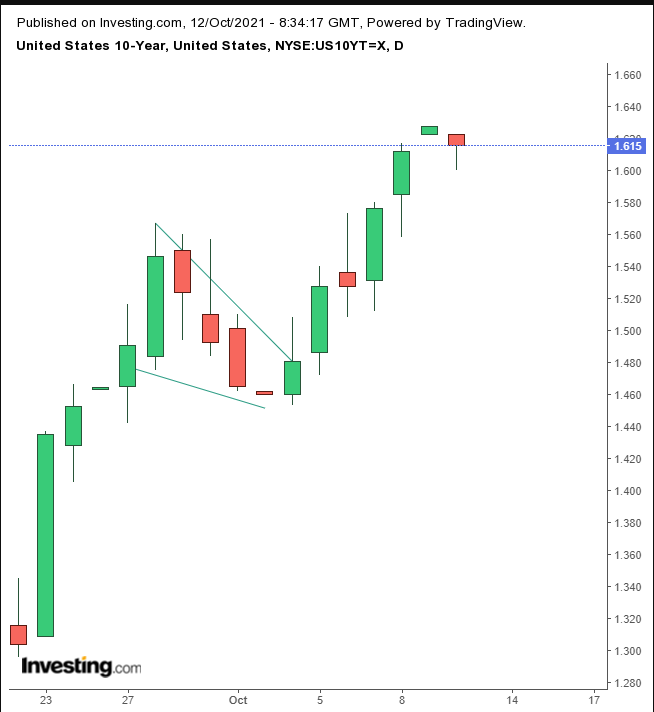
While yields pared much of today’s decline, after yesterday’s rising gap, a close below 1.60 could complete an Evening Star, a three-session reversal pattern.
The dollar tracked yields lower, but it is showing signs of a repeat of the earlier rally.
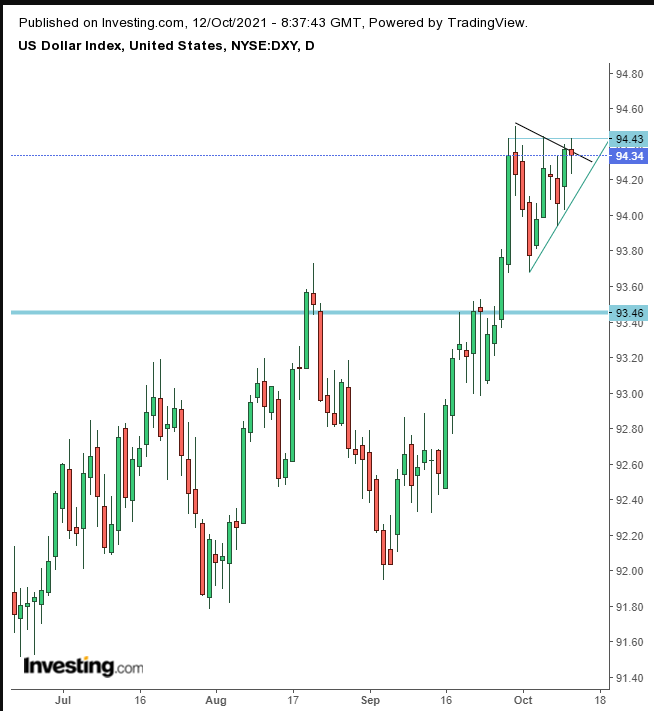
The dollar is testing the top of either a symmetrical or ascending triangle—bullish either way—following the earlier surge and the completion of a massive double-bottom.
Gold was little changed, but the dollar’s weakness helped it rebound from its session low.
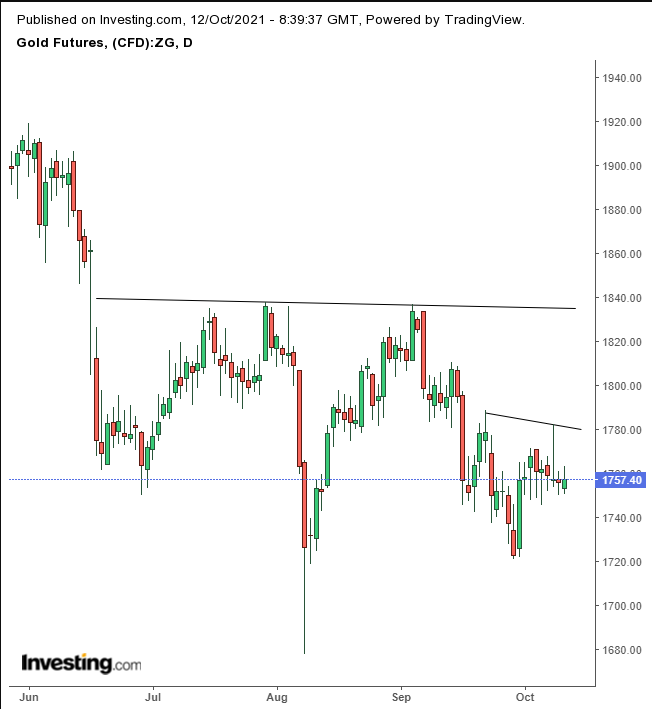
The yellow metal is trading within a small H&S, making up the right side of a larger H&S bottom. However, the patterns require upside breakouts to be complete.
Bitcoin, like gold, rebounded from its session lows, settling, for now, with yesterday’s close—the highest level since May 10.
Crude oil extended a rally to the fourth day, pushing to the $81 mark. The rise comes on the heels of an energy crisis, ranging from Europe to Asia.
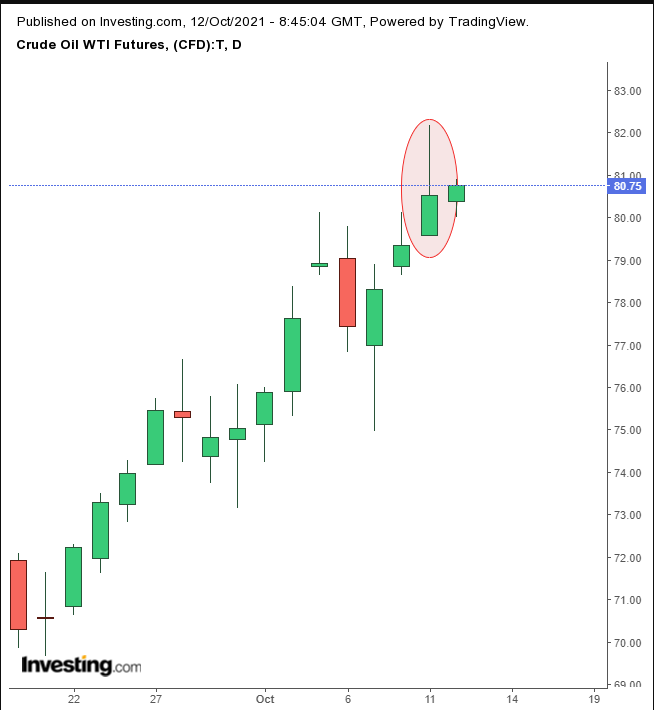
While prices are on the rise, oil is still below yesterday’s high—a shooting star. That candle demonstrates the bears had the last word, and they may have more to say.
Thermal coal futures in China climbed to the second consecutive record.
The energy shortage hit aluminium supplies, pushing its price to a 12-year high.
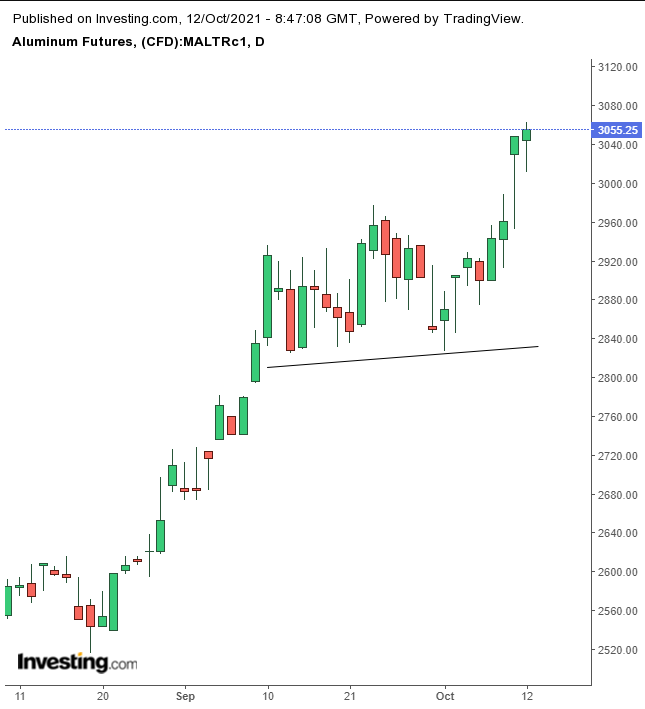
The price blew a H&S top, reversing the market’s direction. Today’s trading overcame yesterday’s hanging man. If the price closes higher, it will blow out the bearish candle as it did the H&S pattern.
